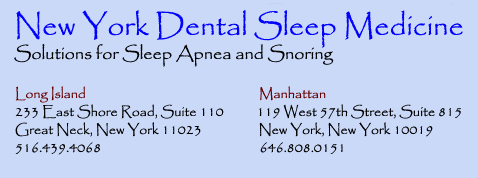 |
 |
  |
- Snoring
- Obstructive Sleep Apnea (OSA)
- Risk Factors for Having Obstructive Sleep Apnea (OSA)
- Diagnosis and Treatment/Management of OSA/Snoring
Snoring:
What Causes Snoring?
During sleep the muscles of the throat and mouth relax, causing a decrease in the airway spaces. The decreased size causes an increased velocityh of air; this causes the soft tissues of the upper airway to vibrate resulting in the noise we call snoring. An elongated soft palate, enlarged uvula, excessive body weight, heavy alcohol consumption, as well as sedatives increase the severity of snoring.
The treatment of Snoring is primarily initiated to help bed partners sleep. Many a couple ends up in separate rooms due to sleep noise. Good sleep positions (not sleeping on your back), and the elimination of alcohol or other sedatives near bed time can be helpful.
With almost a 100% percent success rate, a customized jaw repositioning device can be constructed to pull the lower jaw forward. These devices are similar to orthodontic retainers or sports mouth guards. As the jaw is brought forward, it rings the tongue with it, opening the airway at the bse of the tongue which reduces the speed of air during breathing. This reduces or eliminates the vibrations that cause the noise we call snoring.
Failure to treat significant snoring not only results in cranky spouses, but the elongation of the soft palate and uvula, thickening o fthe walls of the pharynx, and damage to the nerves in the vibrating tissues.
All these changes increase the potential to snore and also the potential of developing Obstructive Sleep Apnea. Snoring can also interrupt the normal sleep cycle resulting indaytime sleepiness and increased potential for medical problems such as high blood pressure.
Snoring in and of itself may primarily cause marital problems, but is significant in that almost all patients with obstructive sleep apnea snore. Obstructive Sleep Apnea (OSA) occurs when the narrowing of the upper airway results in complete blockage of the airway and the resulting asphyxiation lasts longer than several seconds.
The causes of OSA are the same as snoring. Any obstructive condition coupled with the assuming of a supine position may cause a blockage of the upper airway. The build up of carbon dioxide as well as the lack of oxygen (hypoxia) in the blood stream eventually cause the patient to waken and resume breathing, often with a jump or lound noise.
When Obstructive Sleep Apnea isn't treated, the sudden awakening may be a total awakening or bringing the sleep level to a lighter level. When this happens throughout the night, the loss of quality sleep results in symptoms such as excessive daytime sleepiness, cognitive dysfunction, memory and judgement impairment, irritability, decreased sex drive, hypertension, nocturia, sweating, fatigue headaches (particularly in the morning), gastroesophageal reflux, depressioin, weight gain, and an increased tendency for accidents in the home, work place, and particularly in the automobile ( three times the national average).
Risk Factors Associated with Obstructive Sleep Apnea:
- Being overweight - obesity is a major risk factor, as is a large neck size (17inches + in men and 15+ in women).
- Nasal congestion or obstruction , sinus trouble or allergies resulting in nasal blockage.
- Large tonsils and/or adenoids,, a large tongue or small jaw, and the general anatomy of the airway and oral cavity.
- Lung disease, atrial fibrillation and heart failure.
- Scoliosis or muscle weakness.
- Sedating medicines, drugs and alcohol, smoking.
- Hypothyroidism and certain other endocrine (hormonal) disorders. Increasing age.Family history.
- Bruxism (teeth grinding)
- Menopause, progesterone or estrogen deficiencies.
- Male gender, increasing age, and family history.
Diagnosis and Treatment of Obstructive Sleep Apnea and Snoring
The diagnosis of Obstructive Sleep Apnea (OSA) can only be made by a qualified physician, usually via a sleep test (Polysomnogram) at a sleep center. The results of the Polysomnogram combined with the patient evaluation and history determine the presence of sleep apnea. Take a moment and answer a few simple uestionsand determine your likelyhood of having Sleep Apnea. SLEEP DISORDER TEST
Treatment Options: Good sleep hygiene (including position, consistant times, and enviornment), weight loss when appropriate, and exercise are some self help treatments available to the patient. Medical and dental treatments include: Continuous Positive Airway Pressure (CPAP), Oral Appliance Therapy (OAT), and Surgery.
Continuous Positive Airway Pressure (CPAP) is pressurized air generated by a bedside machine. The air is delivered through a tube connected to a mask covering the nose. The force of the pressurized air pushes the soft tissues aside and effectively splints the airway open. This is much like air being blown into a balloon, the CPAP opens widens the airway, preventing the sides from blocking breathing.
Oral Appliance Therapy (OAT): Oral appliances are custom made devices worn in the mouth to treat sleep apnea and snoring. These devices are similar to orthodontic retainers or sports mouth guards. Oral Appliance Therapy involves the selection, design, fitting and use of a custom designed oral appliance that is worn during sleep. The appliance opens the airway by:
- Repositioning the lower jaw, tongue, soft palate and uvula
- Stabilizing the lower jaw and tongue
- Increasing the muscle tone of the tongue
In constructing an oral appliance we work with our pysician as part of the medical team in your diagnosis, treatment and on going care. Determination of the proper therapy can only be accomplished with a joint consultation with your physician. Initiation oral appliance therapy can take from several weeks to to several monthsto complete. Once constructed and placed, we continue to monitor your treatment and evaluate the response of the airway, teeth, and jaws.
Surgical Procedures to open the nasal passages, reduce tonsils and adenoids, alter the soft palate and uvula, and move the lower jaw are available when appropriate.
Tell Your Doctor | Q & A | Contact Us | Testimonials | Resources | About Dr. Fischman | Map & Directions | New patient Forms